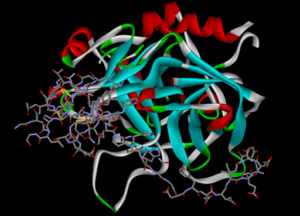 A fiber Bragg grating is an optical interferometer embedded in an optical fiber. At the same time, fiber optics combined with certain substances (usually germanium) can change its refractive factor when the fiber is exposed to ultraviolet light. If such a fiber is illuminated with ultraviolet light with a specific spatial periodic structure, the optical fiber becomes a kind of diffraction grating. In other words, this optical fiber will almost completely reflect the light of a certain, predetermined range of wavelengths, and transmit light of all other wavelengths.
A fiber Bragg grating is an optical interferometer embedded in an optical fiber. At the same time, fiber optics combined with certain substances (usually germanium) can change its refractive factor when the fiber is exposed to ultraviolet light. If such a fiber is illuminated with ultraviolet light with a specific spatial periodic structure, the optical fiber becomes a kind of diffraction grating. In other words, this optical fiber will almost completely reflect the light of a certain, predetermined range of wavelengths, and transmit light of all other wavelengths.
Application of FBG sensors
The FGB application includes the following fields:
- Point sensors (that is able to measure deformation, temperature, pressure, tilt, displacement), embedded in composite materials and others;
- Laser systems and amplifiers (filters, mirrors);
- Telecommunications (dispersion compensation modules, WDM technology);
- Research and development.
Difference between electrical and fiber sensors
For decades, electrical sensors (tensor-resistive, string, potentiometric, etc.) have been the main method of measuring physical and mechanical phenomena. Despite their widespread use, electrical sensors have several disadvantages, such as loss during signal transmission, sensibility to electromagnetic interference, the need to organize a spark-resistant electrical circuit (if there is a danger of explosion). These mentioned above limitations make electrical sensors unsuitable or difficult to use for a number of applications.
The use of fiber optic sensors is an excellent solution to these problems. In fiber optic sensors, the signal is light in the optical fiber instead of electricity in the copper wire at traditional electrical sensors.
Over the past twenty years, a huge number of innovations in optoelectronics and in the field of fiber optic telecommunications has led to a significant reduction in prices for optical components and to a significant improvement in their quality. This factor allows fiber optic sensors to move from the category of experimental laboratory tools to the category of widely used devices in various areas.
Operating principle of Bragg gratings
A fiber Bragg grating or FBG acts as a sensitive element of point fiber optic sensors, which is capable to reflect certain wavelengths of light and transmit all others. This effect is achieved by periodically changing the refractive index in the core of the fiber optics.
When the laser light passes through an optical fiber, a part of it is reflected from the fiber grating at a certain wavelength. This peak of reflected light is registered by measuring equipment. As a result of the numerous parameters influence, the interval between the FBG bundles and the refractive index of the fiber optics change.
Consequently, the wavelength of the light reflected from the fiber Bragg grating changes. In addition, it is possible to determine the exact characteristics of the changes by changing the wavelength. In fiber optic sensors based on Bragg gratings, the measured value is converted to a Bragg wavelength offset. The recording system converts the wavelength offset into an electrical signal.
The sensing element of such FBG sensor does not contain electronic components and therefore it is completely passive, which means it can be used in the area of increased explosiveness, aggressiveness, strong electromagnetic interference. Numerous fiber Bragg gratings can be installed on a single fiber, each of which gives a response at its own wavelength. In this case, instead of a point sensor, we get a distributed sensing system with multiplexing along the wavelength.
The use of the light wavelength as an information parameter makes the FBG sensor insensitive to the long-term changes of the parameters of the source and radiation detector, as well as random attenuation of power in the optical fiber.
Common types of FBG sensors
The following types of fiber optic sensors based on FBG technology are used for automated monitoring:
The principle of FGB sensor operation is based on the modulation of one or several properties of a propagating light wave (intensity, phase, polarization, frequency), which change occurs with a change in the measured physical quantity.
The basis of fiber-optic sensing technology is an optical fiber – a thin glass thread that transmits light through its core. The optical fiber consists of three main components: core, shell, and coating. The shell reflects the scattered light back into the core, allowing light to pass through the core with minimal loss.
It can be achieved by a higher refractive index in the core relative to the shell, resulting in a complete internal reflection of light. The outer coating protects the fiber optics from external influences and physical damage. It can consist of several layers depending on the required protection.
Benefits of fiber sensors based on Bragg gratings
The advantages of FBG sensors include:
- Wide sensing range;
- Possibility to integrate the FBG sensing system into the object structure;
- Full fire and explosion safety;
- Long-distance signal transmission;
- Integration of several fiber optic sensors in one channel;
- Insensitiveness to electromagnetic and radio frequency influences;
- No need for recalibration (stable over time under constant external conditions).
 At the moment, most of the sensors used in the world are electrical sensors. As it was mentioned above, in optical sensors based on fiber Bragg gratings, the signal is light passing through an optical fiber (instead of an electric current passing through a copper wire). This fundamental difference allows FBG sensors to overcome many problems typical for electrical sensors.
At the moment, most of the sensors used in the world are electrical sensors. As it was mentioned above, in optical sensors based on fiber Bragg gratings, the signal is light passing through an optical fiber (instead of an electric current passing through a copper wire). This fundamental difference allows FBG sensors to overcome many problems typical for electrical sensors.
Features of fiber optic sensors
Optical fibers and sensors are non-conductive, electrically passive, and immune to electromagnetic interference. Monitoring with a tunable high-power laser system allows sensing over long distances with virtually no signal loss. In addition, each optical channel is able to monitor a variety of FBG sensors unlike the electrical channel, which significantly reduces the size and complexity of such a sensing system.
Optical sensing systems are ideal for use in conditions where conventional electrical sensors (strain gauge, string, thermistor, etc.) can be difficult to use (long distances, EM fields, explosion safety, etc.). It is easy to switch to fiber optic solutions since the installation and operation of optical sensors are similar to traditional electrical sensors.
Understanding the principles of FBG operation and the benefits of Bragg grating sensor applications can greatly facilitate the solution of various problems in the field of sensing measurement (for example, monitoring of structures).
Nowadays FBG sensors are applied in various fields that require precise and fast measurements. Fiber Bragg sensing systems can be used in aeronautic, automotive, civil engineering structure monitoring, undersea oil exploration, in the mining industry, geotechnical engineering, structural engineering, tunnel construction engineering, etc.
Bragg sensors in medicine
The most promising application of FBG sensors is medicine. Now FBG technology is highly used for fiber-based biomedical sensing including biosensing, safety or security, and structural health monitoring. FBG sensors offer a new and effective way of real-time measurements. They can be applied in laser systems, medical tiny intra-aortic probes, and body sensors for biochemical analysis making.
For example, today fiber Bragg gratings apply optical-fiber sensing probes that are able to dissolve due to such ability as controlled solubility in a physiological environment. Thus, FBG technology enables safer diagnostic of sensitive human organs and there is no need for a surgical extraction. The development of FBG continues, and it is possible that very soon new FBG sensors with improved characteristics appear.
How to choose the right fiber optic product?
If you want to obtain a highly efficient sensing system, you should choose the Optromix company. Optromix is a manufacturer of innovative fiber optic products for the global market. The company provides the most technologically advanced fiber optic solutions for monitoring worldwide. Optromix is a fast-growing vendor of fiber Bragg grating (FBG) products line such as fiber Bragg grating sensors, FBG interrogators and multiplexers, distributed acoustic sensing (DAS) systems, distributed temperature sensing (DTS) systems. If you are interested in FBG sensors and want to learn more, please contact us at info@optromix.com
 Fiber optic technology is highly promising now, in spite of the fact that fiber optic solutions found their place in numerous fields of application, the optical fiber sphere still continues developing. Thus, recently a group of researchers from the UK demonstrated a novel optical pressure-temperature gauge of compact size.
Fiber optic technology is highly promising now, in spite of the fact that fiber optic solutions found their place in numerous fields of application, the optical fiber sphere still continues developing. Thus, recently a group of researchers from the UK demonstrated a novel optical pressure-temperature gauge of compact size.

 A
A  At the moment, most of the sensors used in the world are electrical sensors. As it was mentioned above, in
At the moment, most of the sensors used in the world are electrical sensors. As it was mentioned above, in  Groundwater flow sensing is highly important when it comes to the extraction of drinking water because it allows for avoiding well clogging and pollution. Nevertheless,
Groundwater flow sensing is highly important when it comes to the extraction of drinking water because it allows for avoiding well clogging and pollution. Nevertheless,  At the present time
At the present time  Recently a new simple low-cost technology has been developed for security monitoring of the borders. Initially, the technology that includes
Recently a new simple low-cost technology has been developed for security monitoring of the borders. Initially, the technology that includes  Thrombin plays a very important role in normal and pathological blood coagulation because its high level is an indication of tumor cell presence. Also, the level of thrombin is growing while atherosclerosis, thromboembolic disease, cancer, and inflammatory disease. Thus, its clinical importance provokes the development of devices for fast and precise thrombin detection and most of them are based on aptamers.
Thrombin plays a very important role in normal and pathological blood coagulation because its high level is an indication of tumor cell presence. Also, the level of thrombin is growing while atherosclerosis, thromboembolic disease, cancer, and inflammatory disease. Thus, its clinical importance provokes the development of devices for fast and precise thrombin detection and most of them are based on aptamers. Today environmental change provokes the appearance of new diseases and, finally, human health care requirements continue increasing for several decades. Moreover, it is necessary to have new advanced tools for the disease diagnosis at early stages, for monitoring and treatment of patients. Then unconventional biomedical instrumentation and sensors, including
Today environmental change provokes the appearance of new diseases and, finally, human health care requirements continue increasing for several decades. Moreover, it is necessary to have new advanced tools for the disease diagnosis at early stages, for monitoring and treatment of patients. Then unconventional biomedical instrumentation and sensors, including 
